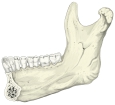


 |
 |
 |
 |
|
下顎体・下顎枝 |
下顎枝 |
下顎骨(全体) |
下顎骨(内側面) |
|
以下は「Wikipedia」の解説文となる。
The body of the mandible is curved, and the front part gives structure to the chin. It has two surfaces and two borders. From the outside, the mandible is marked in the midline by a faint ridge, indicating the mandibular symphysis, the line of junction of the two halves of the mandible, which fuse at about one year of age. This ridge divides below and encloses a triangular eminence, the mental protuberance (the chin), the base of which is depressed in the center but raised on both sides to form the mental tubercle. Just above this, on both sides, the mentalis muscles attach to a depression called the incisive fossa. Below the second premolar tooth, on both sides, midway between the upper and lower borders of the body, are the mental foramen, for the passage of the mental vessels and nerve. Running backward and upward from each mental tubercle is a faint ridge, the oblique line, which is continuous with the anterior border of the ramus. Attached to this is the masseter muscle, the depressor labii inferioris and depressor anguli oris, and the platysma (from below).
【 語 句 】
・faint:わずかな ・ridge:隆起 ・mandibular symphysis:下顎結合 ・enclose:取り囲む ・eminence:盛り上がり ・mental protuberance:オトガイ隆起 ・mental tubercle:オトガイ結節 ・mentalis muscles:オトガイ筋 ・incisive fossa:切歯窩 ・premolar tooth:小臼歯 ・mental foramen:オトガイ孔 ・oblique line:斜線 ・masseter muscle:咬筋 ・depressor anguli oris:口角下制筋 ・platysma:広頚筋
From the inside, the mandible appears concave. Near the lower part of the symphysis is a pair of laterally placed spines, termed the mental spines, which give origin to the genioglossus. Immediately below these is a second pair of spines, or more frequently a median ridge or impression, for the origin of the geniohyoid. In some cases, the mental spines are fused to form a single eminence, in others they are absent and their position is indicated merely by an irregularity of the surface. Above the mental spines, a median foramen and furrow are sometimes seen; they mark the line of union of the halves of the bone. Below the mental spines, on either side of the middle line, is an oval depression for the attachment of the anterior belly of the digastric. Extending upward and backward on either side from the lower part of the symphysis is the mylohyoid line, which gives origin to the mylohyoid muscle; the posterior part of this line, near the alveolar margin, gives attachment to a small part of the constrictor pharyngis superior, and to the pterygomandibular raphe. Above the anterior part of this line is a smooth triangular area against which the sublingual gland rests, and below the hinder part, an oval fossa for the submandibular gland.
Borders
- The superior or alveolar border, wider behind than in front, is hollowed into cavities, for the reception of the teeth; these cavities are sixteen in number and vary in depth and size according to the teeth which they contain. To the outer lip of the superior border, on either side, the buccinator is attached as far forward as the first molar tooth.
- The inferior border is rounded, longer than the superior, and thicker in front than behind; at the point where it joins the lower border of the ramus a shallow groove; for the facial artery, may be present.
【 語 句 】
・concave:凹状の ・mental spines:オトガイ棘 ・geioglossus:オトガイ舌筋 ・geniohyoid:オトガイ舌骨筋 ・furrow:溝 ・digastric:顎二腹筋 ・mylohyoid line:顎舌骨筋線 ・mylohyoid muscle:顎舌骨筋 ・constrictor pharyngis superior:上咽頭収縮筋 ・pterygomandibular raphe:翼突下顎縫線 ・sublingual gland:顎下腺 ・hinder part:後部 ・oval:楕円形の ・submandibular gland:顎下腺 ・hollow:へこます ・buccinator:頬筋 ・molar tooth:大臼歯 ・ramus:枝
■ 写真やイラストを掲載しているサイト ■
・ イラストや写真を掲載しているサイト-Ⅰ
・ イラストや写真を掲載しているサイト-Ⅱ
・ イラストや写真を掲載しているサイト-Ⅲ
